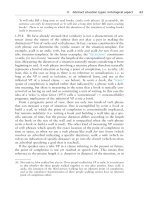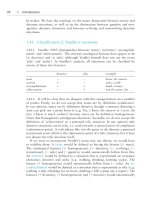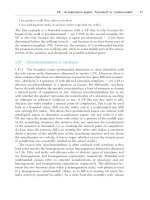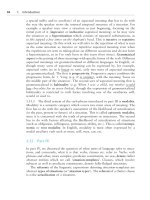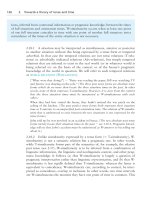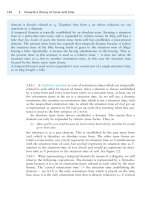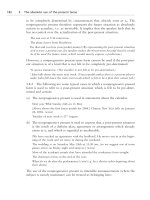The grammar of the english verb phrase part 14 pps
Bạn đang xem bản rút gọn của tài liệu. Xem và tải ngay bản đầy đủ của tài liệu tại đây (63.07 KB, 7 trang )
84 1. Introduction
a special suffix and/or auxiliary) of an aspectual meaning that has to do with
the way the speaker views the internal temporal structure of a situation. For
example a speaker may view a situation as just beginning, focusing on the
initial part of it (ingressive or inchoative aspectual meaning) or he may view
the situation as a hypersituation which consists of repeated subsituations, as
in She tapped a few times on the elephant’s head. This is iterative or repetitive
aspectual meaning. (In this work we will refer to the repetition of what is seen
as the same situation as iterative or repetitive aspectual meaning even when
the repetitions are seen as taking place on different occasions and do not form
a hypersituation, as in I’ve only been in this town three times). Grammatical
aspect is the pairing of these meanings with specific forms of the verb. Different
aspectual meanings are grammaticalized in different languages. In English, al-
though many sorts of aspectual meaning can be expressed by, for example,
aspectual verbs (as in It began to rain), only two sorts of aspectual meaning
are grammaticalized. The first is progressivity. Progressive aspect combines the
progressive form, be ϩ V-ing (e. g. It is raining), with the meaning ‘focus on
the middle part of the situation’. The second sort of aspectual meaning that is
grammaticalized is habituality (e. g. When I was a child, my mother would
buy chocolate for us every Friday), though the expression of grammaticalized
habituality is restricted to verb forms involving one of the auxiliaries will,
would or used to.
1.51.3 The third system of the verb phrase introduced in part III is modality.
Modality is a semantic category which covers two main areas of meaning. The
first has to do with the speaker’s assessment of the likelihood of actualization
(in the past, present or future) of a situation. This is called epistemic modality,
since it is concerned with the truth of propositions or utterances. The second
has to do with factors affecting the likelihood of actualization of situations
(such as obligation, willingness, permission, ability, etc.). This is called nonepi-
stemic or root modality. In English, modality is most often expressed by a
modal auxiliary verb such as must, will, may, can, etc.
1.52 Part IV
In part IV, we discussed the question of what units of language refer to situa-
tions, and conversely, what it is that verbs, clauses etc. refer to. Verbs, verb
phrases and other, more complex, predicate constituents, we saw, denote rather
abstract entities which we call ‘situation-templates’. Clauses, which involve
subjects as well as predicate constituents, denote fully-fledged situations.
The referents of the linguistic expressions denoting situation-templates are
abstract types of situations (or ‘situation types’). The referent of a (finite) clause
is a/the actualization of a situation.
IX. Summary of chapter 1 85
However, most of the time we do not really have to make a strict distinction
between denotation and reference, nor between situation-templates and situa-
tions or between abstract situation types and concrete actualizing situations.
This means that we can, and will, often talk of clauses and even verb phrases
as ‘referring to situations’.
1.53 Part V
1.53.1 In part V we saw how ontological aspect (or Aktionsart,orlexical
aspect) distinguishes different situation-templates according to the semantic
features that are automatically conferred on the template by the choice of lexi-
cal verb and its complements. (Because it is the lexical verb that counts, pro-
gressive or nonprogressive meaning does not play a part in lexical aspect.)
While grammatical aspect is clearly concerned with the internal temporal struc-
ture of a situation, lexical aspect is much more loosely concerned with this.
For example, an important feature is that of (non)agentivity (i. e. agentivity or
nonagentivity, which we can write as [( agentive]). A situation-template is
agentive if it entails an agent that (virtually always intentionally) causes the
situation to actualize. (Compare: Sylvia shouted and Sylvia breaks windows,
which are both agentive, with Sylvia looks determined and The window broke,
which are nonagentive). Agentivity is only indirectly to do with how the situa-
tion is seen as unfolding in time, in that it may affect the possibility of using
the progressive, and of using verb phrases in certain ways. (Compare: Sylvia’s
breaking windows with her fellow protesters tomorrow (agentive) with *Syl-
via’s looking determined tomorrow (nonagentive)).
1.53.2 The other features Ϫ all binary, like (non)agentivity Ϫ that play a role
in lexical aspect are briefly repeated here. A situation-template may be static
or it may be nonstatic (dynamic). A static situation-template is one which refers
to a situation type that involves no change and requires no energy in order to
continue actualizing. Such situations include habits (as implied by the template
walk to work every day). Conversely, a type of situation referred to by a dy-
namic situation-template involves change and requires an input of energy in
order to actualize or to continue actualizing. The term ‘static’ is extended to
situations and to clauses which contain a static verb phrase. (The same, natu-
rally, applies to the term ‘dynamic’). Verbs which only denote static situations
are called static situation verbs or state verbs, and verbs which only denote
dynamic situations are called dynamic situation verbs.
1.53.3 The feature [( homogeneous] also belongs to the realm of lexical
aspect but only in a limited way. The meaning of homogeneity is most easily
explained by considering types of situations. Homogeneous situation types are
86 1. Introduction
ones in which every portion of the situation can be described in the same
way as the whole situation (for example drink beer). Nonhomogeneous,or
heterogeneous, types of situations are made up of parts which are each different
from the whole (for example drink a glass of beer, in which no single part of
the situation constitutes a full instance of drinking a glass of beer).
Some of the information which determines the (non)homogeneity of a con-
crete actualization of a situation is lexical information found in the situation-
template, and in some cases the (non)homogeneity of a clause can even be fully
determined by the situation-template. However, apart from the fact that the
nature of the subject NP may affect the interpretation of the actualization of a
situation as homogeneous or not, it is often not possible to decide on the
homogeneity of a situation unless we know whether or not the clause referring
to it receives a progressive interpretation. This in turn, of course, is often de-
pendent on grammatical aspect. Thus, if we take the telic situation-template
represented by drink a glass of beer, it may be involved in the representation
of (the actualization of) a situation as nonhomogeneous as well as one which
is homogeneous: Sylvia drank a glass of beer represents its situation as nonho-
mogeneous, Sylvia was drinking a glass of beer focuses purely on the activity
in progress and represents the actualization of the situation referred to as
homogeneous. (In addition, a habitual interpretation may also alter the homo-
geneity value of a situation, since a habit is a kind of state, and habituality
may be indicated by elements outside the predicate constituent, as in Elephants
are intelligent, where the repetitive-habitual aspect of meaning is induced by
the generic plural subject NP.) In sum, (non)homogeneity is ultimately a feature
of clauses referring to actualizing situations, but it can be determined by the
nature of the situation type, or/and by the (non)progressive or (non)habitual
aspectual interpretation that is assigned to the clause.
1.53.4 An important distinction made at the level of situation-templates Ϫ
but, like most of the distinctions discussed here, a distinction which is often
applied by extension to clauses and to situations Ϫ is that between punctual
and durative situation-templates. Punctual situation-templates imply a situa-
tion which is conceived of as taking up no measurable time, or lasting just a
moment, while durative situation-templates imply a situation conceived of as
extending over an appreciable interval. Verbs that are typically used to refer to
punctual situations are called ‘punctual situation verbs’, but even such verbs
may sometimes be involved in the reference to durative situations. This hap-
pens most notably when a punctual situation verb is used in a clause that is
interpreted as referring to the repetition of a punctual situation, so that the
repetitions constitute a durative hypersituation. For example, Sylvia smashed a
window is interpreted as referring to a punctual situation, but Sylvia smashed
twenty windows is normally interpreted as referring to a durative situation
IX. Summary of chapter 1 87
composed of multiple instances of window-smashing rather than as a single
punctual situation of smashing twenty windows simultaneously.
1.53.5 A situation-template (and hence, informally, a situation) may be transi-
tional or nontransitional. A transition consists of a (punctual) change from one
state to another. In open the window the situation-template involves the win-
dow undergoing a transition from the state of being closed to the state of being
open (as a result of some sort of agency). In Meg opened the window the entire
transition is referred to; in Meg was opening the window only the preparatory
phase leading up to the actual transition.
1.53.6 A situation-template is telic if it denotes a type of situation which is
represented as tending towards an inherent terminal point, without which the
situation is not complete and at which it naturally comes to an end. An exam-
ple is Sylvia {drank / was drinking} a glass of beer. Otherwise, it is atelic, for
example Sylvia {drank / was drinking} beer.
1.53.7 Finally, a situation-template may be evolving or nonevolving. A situa-
tion that is [ϩ evolving] is one involving a gradual process of change that is
not represented as caused by an agent, for example The beer was fermenting.
1.53.8 Of course, in any given situation-template we will be able to discern
one value or the other (i. e. a plus or a minus) for most if not all of the features
discussed above. Thus a situation-template like break a window can be charac-
terized as [ϩ agentive], [ϩ dynamic], [ϩ telic], [ϩ transitional] and [Ϫ dura-
tive]). (Since the template is punctual, the features [( evolving] and [( homo-
geneous] do not apply).
1.54 Part VI
In part VI we explained how we can use different combinations of lexical
aspect values, in combination with information from subject NPs, to divide
into broad types the situations denoted by whole clauses. The two most fre-
quently used categorizations of situation types are those described by Lyons
(1977) and Vendler (1967), or variations on these. Because we have some reser-
vations about Vendler’s categorization, we are adopting (our own version of)
Lyons’ taxonomy. This divides situations into four types: states, actions, events
and processes. These can all be distinguished from one another by reference to
just three parameters (i. e. three features of lexical aspect): [( static], [( evolv-
ing] and [( agentive]. As shown in the chart in section 1.42.5, states are static,
nonevolving and nonagentive; actions are nonstatic, nonevolving but agentive;
processes are nonstatic, evolving and nonagentive; and events are nonstatic,
nonevolving and nonagentive.
88 1. Introduction
1.55 Part VII
1.55.1 In part VII we introduced ‘actualization aspect’, i. e. the distinction
between boundedness and nonboundedness. An actualizing situation may or
may not be represented as coming to an end, i. e. as reaching a (natural or
arbitrary) terminal point. It will be clear that boundedness is essentially con-
cerned with the right temporal boundary of the actualizing situation, and it
turns out that many elements may provide this boundary. For example, the
object NP determines, respectively, the boundedness and nonboundedness of
the (actualizations of the) situations represented by Sylvia broke a window last
night and Sylvia broke windows last night. (In the latter example, although we
can assume that in the extra-linguistic world Sylvia stopped breaking windows,
there is no linguistic specification of a terminal point.) In some cases, bounded-
ness is merely an implicature arising from the Gricean Maxims of conversation
or from our knowledge of the world. In that case we speak of W-boundedness,
in contrast with linguistically indicated L-boundedness.
1.55.2 We should distinguish on the one hand between (non)boundedness
and (non)homogeneity and on the other hand between (non)boundedness and
(a)telicity. While [ϩ bounded] and [Ϫ homogeneous] pick out identical sets of
situations, and [Ϫ bounded] and [ϩ homogeneous] do likewise (so that it is
not, for example, possible to have a situation which is [ϩ bounded] and [ϩ
homogeneous]), the two features nevertheless refer to different aspects of those
situations. (Non)boundedness refers to whether or not the actualization of the
situation reaches a terminal point, while (non)homogeneity refers to whether
or not the internal consistency of the situation is uniform, i. e. whether any
(relevant) part of the actualizing situation is representative of the whole situa-
tion. The same symmetry does not exist when it comes to (non)boundedness
and (a)telicity. It is possible for a telic situation-template (e. g. climb over the
wall) to be used in a clause which represents the actualization of a situation
as bounded (e. g. She climbed over the wall) and in one which represents the
situation as nonbounded (e. g. She was climbing over the wall). This is because
telicity deals with whether or not a type of situation is represented as having
an inherent terminal point (which is a point of completion) whilst boundedness
deals with whether or not an actualizing situation is represented as actually
reaching a terminal point (which, depending on whether the situation is telic
or atelic, may or may not be a point of completion).
1.56 Part VIII
Finally, in part VIII, we saw that the three different types of aspect (viz. onto-
logical aspect, grammatical aspect and actualization aspect) interact so as to
determine the aspectual meaning of a given sentence. For example, progressive
IX. Summary of chapter 1 89
meaning, whether grammatically expressed or not, always produces nonbound-
edness, irrespective of whether the situation-template is telic (as in I’m going
to write a book) or atelic (as in This time next year I’ll be writing poetry).
